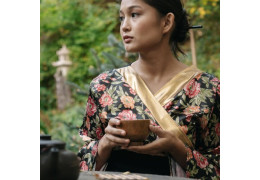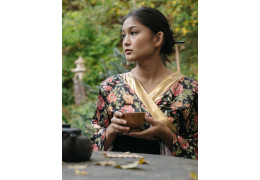The Japanese tea ceremony
In Japan, the tea ceremony is rooted in history and culture. It reflects the art of preparing and sharing matcha. In a humble home, the host uses bamboo utensils to prepare the green tea. Guests then taste the matcha in a decorated bowl, the centerpiece of the ceremony. This ritual of precise gestures is the fruit of Chinese traditions and Zen Buddhism. Its origins date back to the 12th century, but most of its codes were established by tea master Sen no Rikyū in the 16th century.
History of Japanese tea and the ceremony
The history of tea in Japan began in the 9th century, when a monk brought tea leaves from China. In the 12th century, Zen master Eisai extolled the benefits of tea and matcha. Inspired by Chinese ceremonies and Buddhism, he passed on the art of tea to the Japanese. The tea ceremony known as chanoyu was born. Subsequently, Sen no Rikyū perfected the tea ceremony. This great 16th-century tea master established the principles to be followed in the ceremony: harmony, respect, purity and tranquility. Today, you have to go to a special school to learn chanoyu. The Urasenke school remains the most famous.
Japanese ceremony equipment
During the tea ceremony, the host and guests use a variety of utensils and objects with specific functions.
- Chawan bowl. Often handmade from ceramic, bowls are the centerpieces of Japanese service. They play an important role in the tea ceremony. The bowl has a decorated side and a neutral side.
- Chasen: small bamboo whisk. The host uses it to mix the matcha powder with the water.
- Cha ire: tea caddy containing matcha powder prior to tea preparation.
- Chashaku: small scoop for transferring the powder from the cha ire to the bowl.
- Hishaku: bamboo ladle with a long handle. The host uses it to transfer the water.
- Chakin: piece of cloth used to wipe the bowl.
- Fukusa: silk square used by the host for various gestures.
The Japanese tea ceremony from A to Z
The tea ceremony is an intimate affair, with a maximum of five guests allowed to take part. A true ritual in Japan, it unfolds according to precise, orderly gestures. In its full version, it can last up to four hours. Here's how the tea master and his guests behave.
Welcoming guests to the pavilion
The tea ceremony takes place in a small house. Before reaching the house, the host guides his guests through a Zen garden, reconnecting them with nature. On arrival at the pavilion, each guest washes his hands and rinses his mouth with water, to purify himself from the outside world.
Respect for guests on arrival
The host welcomes guests as they enter the pavilion. Guests take off their shoes. The low door forces them to bow, as a sign of respect to the tea master. At the entrance, an alcove displays a bouquet of seasonal flowers, along with a painting or calligraphic scroll. Guests admire the decoration in silence and compliment the host on the arrangement. They then walk through the house, soaking up the harmonious Zen atmosphere. Finally, they take their places on the tatami, kneeling in seiza position.
Seasonal meal or sweet delicacies
The tea ceremony begins with a light, refined, vegetarian, seasonal meal, known in Japanese as kaiseki. The meal is optional, but some ceremonies start with sweet dishes.
Cleaning the service and preparing the matcha
The heart of the chanoyu begins. The host heats water in a cast-iron kettle over a charcoal fire. He then gathers his utensils and cleans them one by one with his fukusa. Before preparing the matcha, he rinses the bowl and the chasen. To prepare the matcha, the tea master takes the powder from the canister using the chashaku. He places the matcha in the bowl and transfers water from the kettle with the bamboo ladle. He whips the mixture with the chasen until a smooth green tea is obtained. Depending on the season or type of ceremony, the host chooses to prepare a light or thick matcha, varying the quantity of powder and water.
Tasting matcha tea in the bowl
Once the tea preparation is complete, the host hands the bowl to the first guest, the guest of honor. The latter raises the bowl to the tea master and greets the second guest, as a sign of respect. He then turns the bowl's decoration towards the host. This detail plays an important part in the ceremony. He takes a first sip and gives his appreciation to the host, before taking two more sips. He wipes the rim of the bowl before passing it to the second guest. Each guest takes three sips. The last guest hands the chawan to the guest of honor, who takes a moment toadmire the beauty of the object before returning it to the host.
The end of the ceremony
The tea master chooses whether to prepare another bowl of matcha or to end the ceremony. In the latter case, he presents the utensils to the guests after cleaning them one by one. Guests marvel at the elegance and sobriety of the objects. Finally, the host silently escorts his guests out of the pavilion. The chanoyu is finished. You don't have to be Sen no Rikyū or attend the Urasenke school to enjoy a bowl of Japanese tea. For a tea ceremony at home, try our matcha tea.



